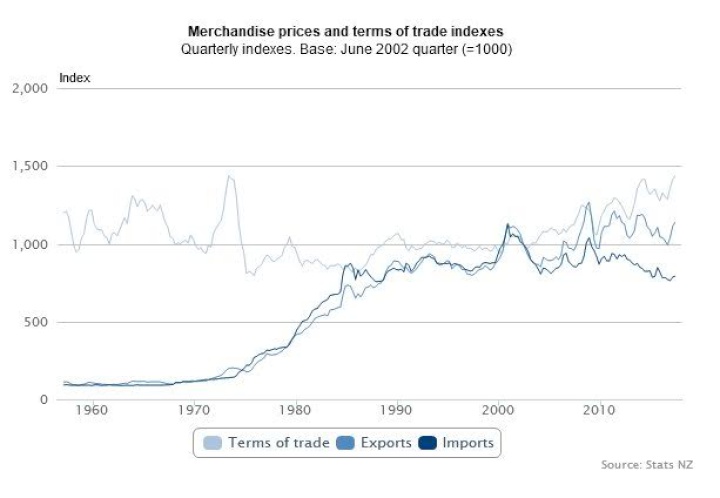Terms of trade just shy of all-time high
Terms of trade just shy of all-time high
1 September
2017
Record butter prices and high prices for meat helped lift the merchandise terms of trade by 1.5 percent in the June 2017 quarter, Stats NZ said today. This was just shy of the all-time high set 44 years ago in the June 1973 quarter.
Terms of trade is a measure of the purchasing power of New Zealand’s exports abroad and an indicator of the state of the overall economy. The 1.5 percent rise in the June quarter means New Zealand can buy 1.5 percent more imports for the same amount of exports.
“The 1.5 percent rise in terms of trade in the June quarter follows a 3.9 percent increase in the March 2017 quarter,” prices senior manager Jason Attewell said today. “Because the March provisional quarter was revised down from 5.1 percent, the terms of trade didn’t quite reached the record high as expected, but it is very close.”
The June 2017 quarter rise in the terms of trade is due to a 2.4 percent rise in export prices and a 0.9 percent rise in import prices.
The rise in export prices was largely due to higher meat and dairy prices. Meat prices were up 9.2 percent, with increases for beef, sheep, and other meat. A 3.9 percent increase in dairy prices was influenced by higher butter and cheese prices, while milk powder prices fell slightly.

“Shoppers can see
the impact of high international prices. The average price
paid by households for a 500g pack of salted butter reached
a peak of $5.05 in June,” Mr Attewell said. “And the
average price for a 1kg block of mild cheddar was $9.25, up
20 percent compared with June last year.”
The 0.9 percent rise in import prices in the quarter slightly offset the effect of export prices in the terms of trade. The import price increase reflects higher prices for products including machinery and cars, and was partly offset by lower prices for crude oil imports.
Ends


 John Mazenier: Gaffer Tape And Glue Delivering New Zealand’s Mission Critical Services
John Mazenier: Gaffer Tape And Glue Delivering New Zealand’s Mission Critical Services Earthquake Commission: Ivan Skinner Award Winner Inspired By Real-life Earthquake Experience
Earthquake Commission: Ivan Skinner Award Winner Inspired By Real-life Earthquake Experience Reserve Bank: Consultation Opens On A Digital Currency For New Zealand
Reserve Bank: Consultation Opens On A Digital Currency For New Zealand NIWA: Ship Anchors May Cause Extensive And Long-lasting Damage To The Seafloor, According To New Research
NIWA: Ship Anchors May Cause Extensive And Long-lasting Damage To The Seafloor, According To New Research New Zealand Customs Service: A Step Forward For Simpler Trade Between New Zealand And Singapore
New Zealand Customs Service: A Step Forward For Simpler Trade Between New Zealand And Singapore Horizon Research: 68% Say Make Banks Offer Fraud Protection
Horizon Research: 68% Say Make Banks Offer Fraud Protection



